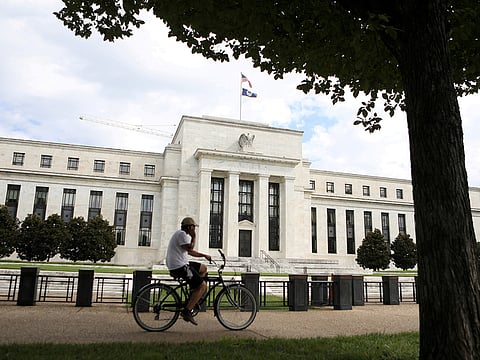Treasury market’s big recession trade gathers momentum
The US economy has so far shown itself to be quite resilient in the face of rate hikes

The bond market is zeroing in on a US recession next year, with traders betting that the longer-term trajectory for interest rates will be down even as the Federal Reserve is still busy raising its policy rate.
Long-dated Treasury yields are already below the Fed’s overnight benchmark range - currently 3.75 per cent to 4 per cent - and there’s still an extra percentage point of central bank increases priced in for the coming months. Activity has also emerged in the options market that suggests some are hedging against the risk that policy rates could eventually halve from their current level.
Rather than wait for conclusive economic evidence that this year’s frenetic monetary tightening will deliver recessionary conditions in 2023, investors have been buying bonds - a stance advocated by Pacific Investment Management Co., among others.
“Fed policy is dynamic and they are still signaling they are going to go higher,” said Gregory Faranello, head of US rates trading and strategy at AmeriVet Securities. “But the market trades like it is more comfortable with the Fed getting to an end game.”
Demand for Treasuries with longer tenors this week dragged the rate on 10-year and 30-year securities below the lower bound of the Fed’s overnight range. With front-end rates holding relatively steady, that’s seen an intensification of the most pronounced yield curve inversion in four decades - a widely watched indicator of potential economic pain to come.
“The recession indicator narrative is strong, but from the Fed’s perspective it is part of the solution,” said Faranello.
The US economy - and in particular the labour market - has so far shown itself to be quite resilient in the face of Fed rate increases, which are aimed at trying to curb high and seemingly persistent inflation. Investors will therefore be keenly attuned to the monthly jobs report this coming Friday for signs of cracking, or indications about whether it might pave the way for the Fed to tweak its policy course.
They’ll be scrutinising carefully the words of Fed Chair Jerome Powell and his colleagues, who will speak publicly next week for the last time before heading into the customary blackout period ahead of the Fed’s December 13-14 policy meeting. While minutes of their most recent meeting showed that they’re likely to slow the pace of tightening soon, officials have been firm in reiterating the need for policy rates to move above current levels.
At this stage of the cycle, Fed jawboning may prove less effective than the tone of data, given expectations of a gradual slowing of policy tightening from here amid a conviction that inflation has peaked and job creation is slowing.
The scale of bullishness in the long-end of the bond market right now - and the depth of the yield curve inversion - means that there could be some turbulence for Treasuries as traders navigate a range of top-tier data in the coming week, not just the jobs report. Recession bets could find succor from a forecast contraction in the ISM manufacturing gauge, while the personal income and spending report will show how things are evolving on personal consumption expenditure, the Fed’s preferred gauge of inflation. Figures on the number of job openings are also scheduled for release.
Current swap-market pricing shows the effective fed funds rate rising to around 5 per cent by the middle of next year, followed by a pullback that takes it more than half a percentage point lower by early 2024. But some are betting on a much sharper reversal, with trades this week tied to Secured Overnight Financing Rate futures focused on the possibility of a decline to 3 per cent or even 2 per cent by either the end of 2023 or early 2024.
That said, there is resistance in some quarters to the current bond market consensus about the Fed, the economy and of course the eventual return of low inflation next year. This week Goldman Sachs Group Inc. said the 10-year will trade above 4 per cent through to 2024 as expectations for rate cuts next year are dashed by the economy not entering a recession and inflation remaining high.
That’s far from the central view though. Market pricing is suggesting that even if the Fed itself is not yet pivoting on policy, many investors are increasingly turning their eyes away from the risk of relentless Fed hikes and toward a possible economic slump.
Sign up for the Daily Briefing
Get the latest news and updates straight to your inbox

_resources1_16a08544ee2_large.jpg?w=320&auto=format%2Ccompress&fit=max)

